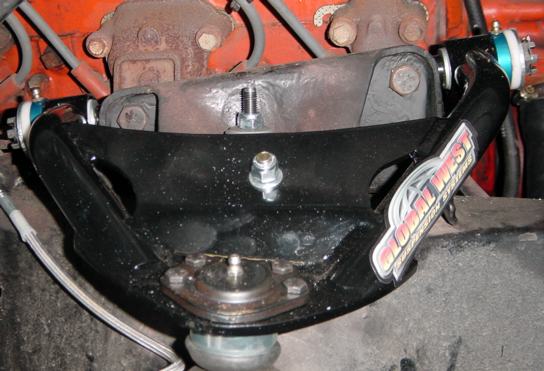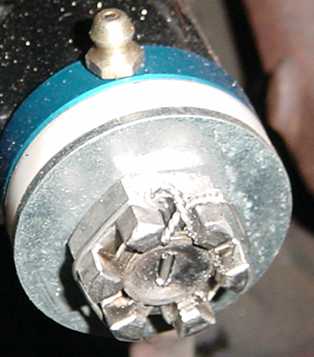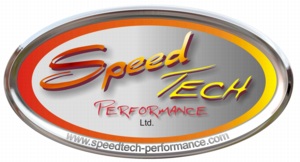

Besides their great looks, the polished stainless steel shaft looks very beefy. The bushings used are greaseable Delrin which operates very smoothly under load unlike Pollyurethane which is stickier stuff. The bushing retention nuts are now castle nuts with cotter keys, (the first fiew came with crimped type stover nuts) the castle nuts are a design improvement for added safety and hopefully it will make the tech inspectors happy too. All the welds (mig) look great and appear to be of high quality, a little better looking than my wife's second gen Global West arms, mainly due to the polished stainless shafts. The arms are made of MIG welded seamless steel tube aprox .125 wall, with laser cut steel plate. There is no weight savings over stock arms but these arms are certainly stronger than stock with the addition of improved geometry.
The Speed Tech arms come completely assembled with stainless steel shaft, Delrin bushings with zerk fittings, bump stop, Moog balljoint, and are powdercoated black. Speed Tech also offers annodized aluminum balljoint covers for the top of the balljoint.
INCREASED POSITIVE CASTER I bolted the arms onto a subframe and the positive caster angle increased by 3.5 degrees over stock arms. Achieving higher caster alignment should be easier with these upper arms. The balljoint appears to be positioned to the rear aprox 9/16 over stock arms.
CAMBER GAIN I noticed a slight increase in neg camber gain, it might be due to the extra caster these arms have, or that my earlier measurements might have a slightly different starting point for zero.
ROLL CENTER HEIGHT The small amount if extra neg camber gain would probably result in slightly more rollcenter movement but not a significant amount. The Guldstrand mod DOES raise the roll center height by itself.
I have no data on the Global West or Detroit Speed upper arms. I would guess they are pretty close to these arms in strength and geometry improvement. I know the GW and DSE arms have similar goals to the Speed Tech arms. The Global West arms use a steel upper shaft, the DSE arms use a stainless steel shaft with oval mounting hole slots in it. Inserts are provided for increased caster adjustment range. The GW Del-A-Lum bushings are very nice, and have some grooves inside to distribute the grease evenly. The Speed Tech bushings have grooves in the aluminum outer shell. I haven't seen the DSE bushings.
Other manufacturers of first gen Camaro upper control arms are: BMR Heidt TSS Fatman Pole Position They DO NOT say that their arms improve geometry, I would not use them.
I'm going to try a pair of these arms on my 67 Camaro, they look like they will do what I want and the quality is great. The Global West and DSE are, of course, good products and improve geometry and alignment the same way, I recommend them too.
NOTE: I have learned the GW and DSE arms are TIG welded, the Speed Tech arms are MIG (wire) welded. TIG is a very slow and precise welding proccess and usually can achieve higher penetration welds. MIG welds on thin tube can be very strong too since the tube is easy to heat up and get penetration. As in any welding, the skill of the person doing it is critical. Welding thin to thick metals can be very difficult for a MIG welder. I have to rate the DSE and Global West arms higher than the Speed Tech because of the welding method used, however there is no proof I have seen that the Speed Tech arms are not very very strong and that the MIG welds on them are not up to the job. I have MIG welded many many farm ripper shanks which are 1" thick by 3" wide all using the MIG proccess and the welds have been strong enough that the shanks have broken somewhere else when they hit rocks, so all my MIG welds have been tested in-use!
|
BUMP |
SPEED TECH+ Guldstrand mod* |
STOCK ** from magazine |
STOCK + Guldstrand mod *** |
|
|
|
|
|
|
|
|
|
|
|
|
|
||
|
|
|
|
|
|
|
|
||
|
|
|
|
|
|
|
|
||
|
|
|
|
|
|
|
|
||
|
|
|
||
|
|
|
||
|
REBOUND |
|
NOTE 1. "0" HEIGHT is factory ride height taken from my 1967 GM service manual. It states "the bottom of the balljoint inner edge should be 2 5/8" lower than the inner A arm pivot bolt". This is higher than most handling prepared Camaros. this ride height puts the balljoint actual pivot point 1 3/4" above the inner A frame pivot point height.
NOTE 2. Most lowered Camaros would use 1.5 or 2" as 0 starting point. I will do another chart using a more common 0 point.
BELOW LEFT: notice the Speed Tech balljoint is closer to the top of the photo (rear of car) than the stock arm, at least it would be if I'd taken the photo straight! I guess the arms are straight across and the shafts are at an angle showing the RH balljoint is moved to the rear.
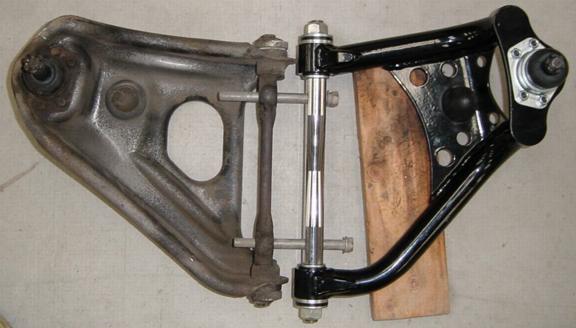
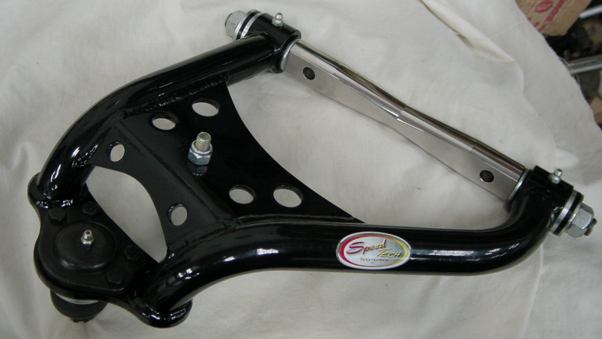
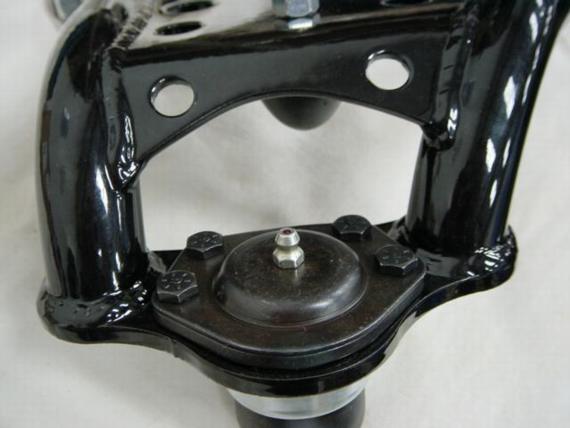
I bought a pair of Global West second gen upper arms for our 73 Camaro, since I allready had some GW bushings, and new balljoints, I ordered the arms bare. The GW second gen upper arms have a larger bushing bore which is used on later second gen's, so I had to then buy new larger bushings.
If you use your stock cross shafts, the castle nuts can/t be used, the shafts threads are too short. I managed to make them work by turning down the nuts in a lathe and drilling, but only had room to use safety wire instead of a cotter pin. I suggest you buy the GW shafts or before assembly, weld some metal on the ends of your shafts to make it work.
The arms look great and fit on the car with no other problems, they appear to have the balljoint moved to the rear around 3/4". Caster should increase 4 to 5 degrees, I haven't measured it yet, so just a guess.
Yeah, I know, not even headers! Just give use some time to get there, SUSPENSION COMES FIRST!... By the way, the specs all over the arms are shavings from drilling holes, not defects in the powdercoat.
